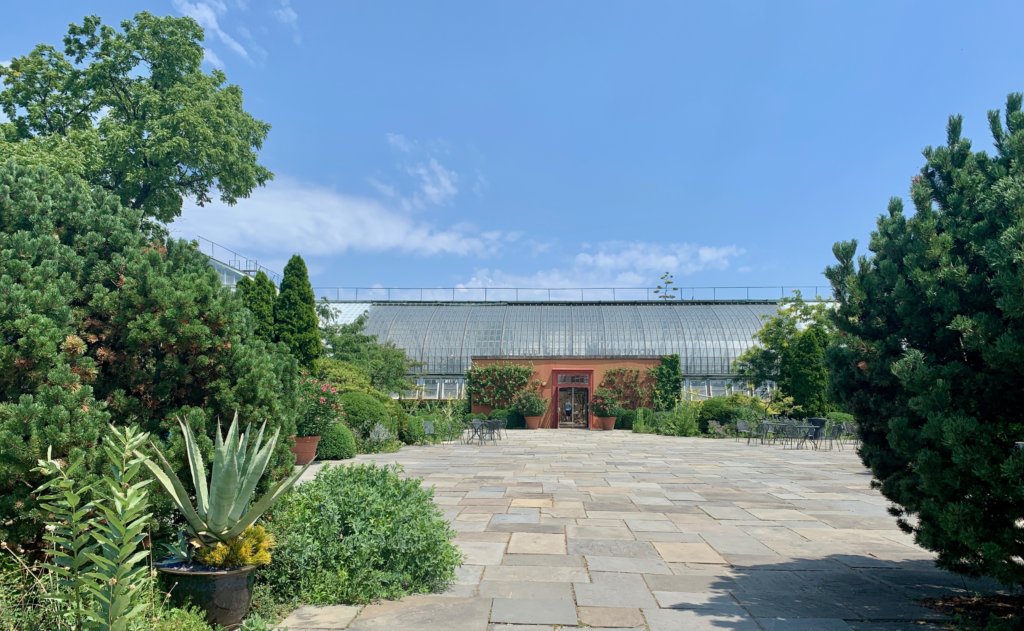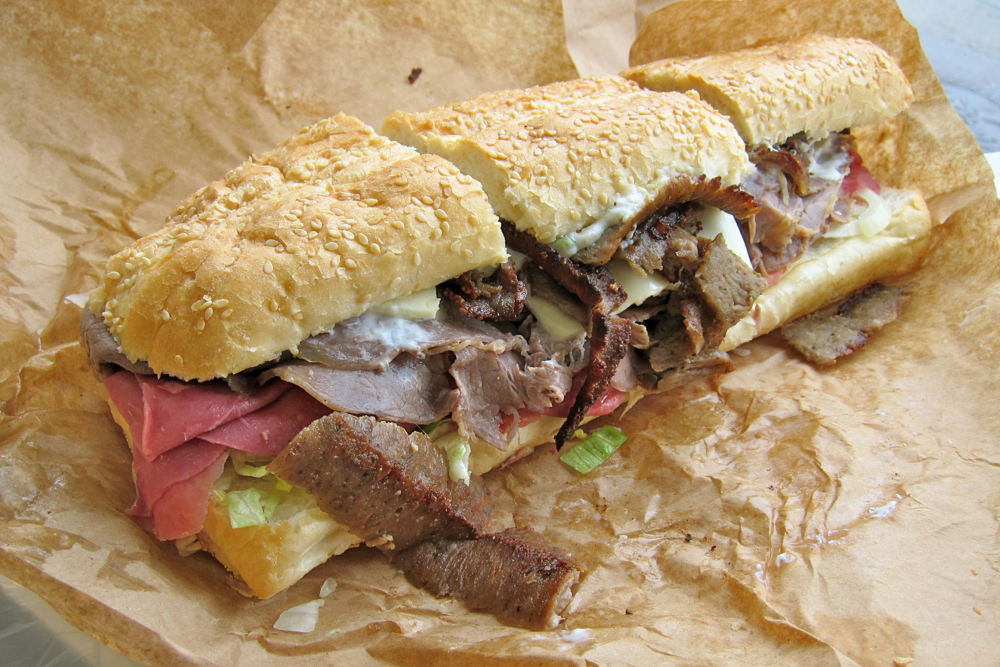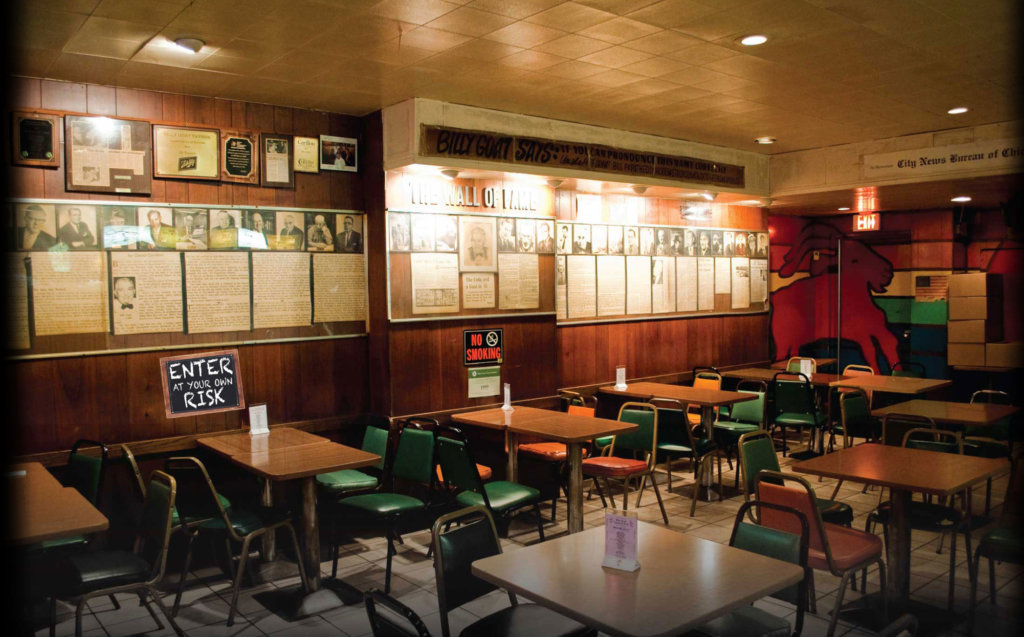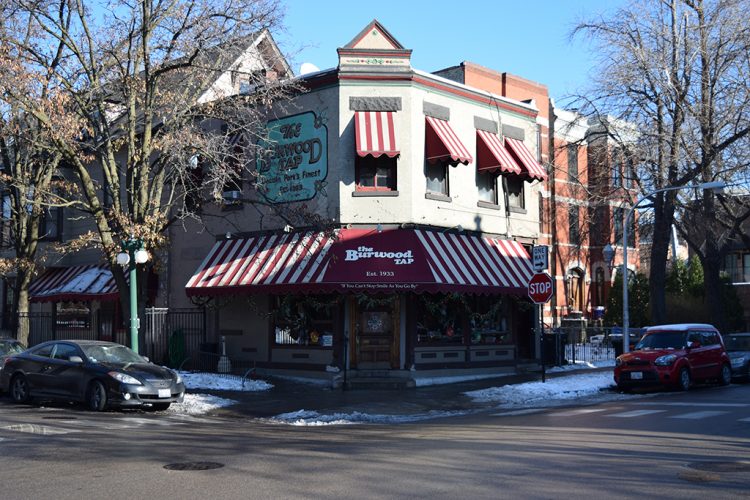8 Great Parks in Chicago That You Can Get to by L Train
– By Tom Schaffner
If you enjoy reading about the best parks in Chicago, then consider signing up for our blog newsletter!
With more than 600 parks comprising 8,800 acres of green space, the Chicago Park District is the largest municipal park manager in the nation. It also is responsible for 28 indoor pools, 50 outdoor pools, and 26 miles of lakefront including 23 swimming beaches and one inland beach.
The city’s park system is also convenient. A recent study found that 98 percent of all city residents live within a 10-minute walk — or roughly half a mile — of a public park. In other words, serenity is not very far away.
Since we offer Chicago walking tours that utilize the L to visit neighborhoods throughout the city and suburbs, we’ve compiled a list of our favorite neighborhood parks that are also easily accessible via the L.
Best Parks in Chicago With Easy Access to the L
- Ping Tom Memorial Park (Via Green Line)
- Garfield Park (via Red Line)
- Wicker Park (Via Blue Line)
- Douglas Park (Via Pink Line)
- Grant Park (Via Any Line Except Yellow)
- Gillson Park (Via Purple Line)
- Humboldt Park (Via Blue Line)
- Oz Park (Via Brown Line)
1. Ping Tom Memorial Park (Via Red Line)
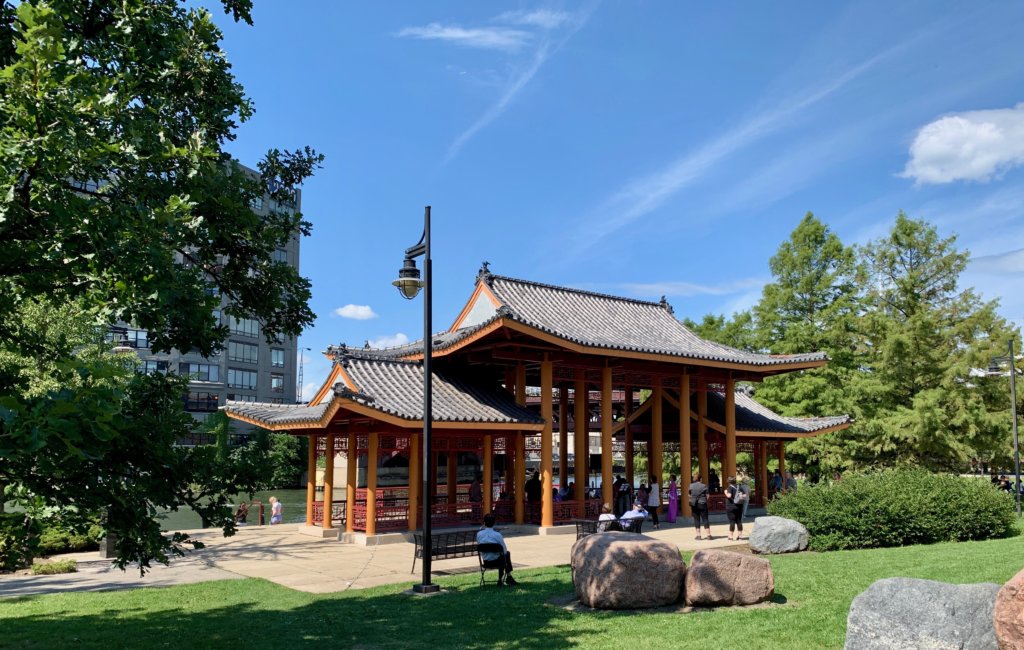
This beautiful 17.24-acre park is located on the south bank of the Chicago River, a few blocks from the Cermak-Chinatown stop on the CTA’s Red Line and, of course, the Chinatown neighborhood (which you see more of on our Chicago Chinatown Food Tour.). Named for Ping Tom, a prominent Chinatown businessman and civic leader, the park was created in October 1999 and features a pagoda-style pavilion, bamboo gardens and a playground. In warmer weather, the Chicago Water Taxi makes scheduled stops at Ping Tom Park from various downtown locations.
2. Garfield Park (Via Green Line)
Only steps from the Green Line, Garfield Park is a 184-acre green space that was designed by William LeBaron Jenney, architect of the world’s first skyscraper (Chicago’s Home Insurance Building). It is the oldest of the city’s three original West Side Parks, which include Humboldt Park and Douglas Park. The centerpiece of the park is the 4.5-acre Garfield Park Conservatory, one of the largest greenhouse conservatories in the United States. Open year-round, the conservatory is particularly enticing in the middle of winter when it offers visitors an escape from the white snow into a world of green. You can experience the Garfield Park Conservatory during our Fulton Market tour!
3. Wicker Park (Via Blue Line)
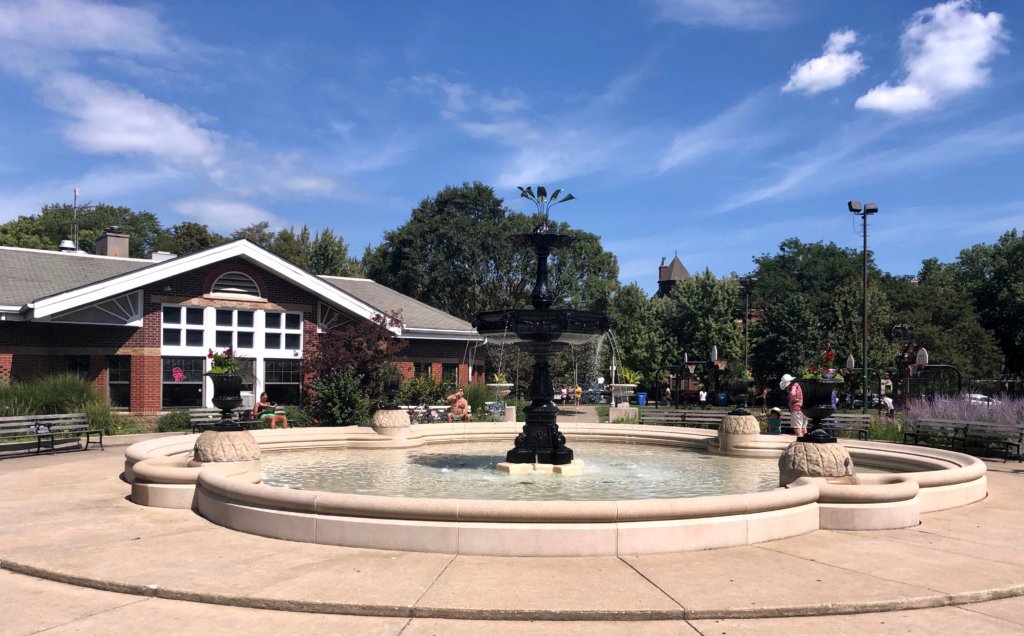
Though only four acres, Wicker Park is a much-beloved and widely-used community park in the heart of one of Chicago’s toniest neighborhoods. Located only steps from the Blue Line L stop at Damen, Wicker Park is dog-friendly and includes baseball diamonds, a walking path, a spray pool and a water playground for children and a statue of Charles Wicker, who, with his brother Joel, donated the park to the community in hopes that it would one day spur development within the community. It did, perhaps well beyond even the wildest dreams of the Wicker brothers.
4. Douglas Park (Via Pink Line)
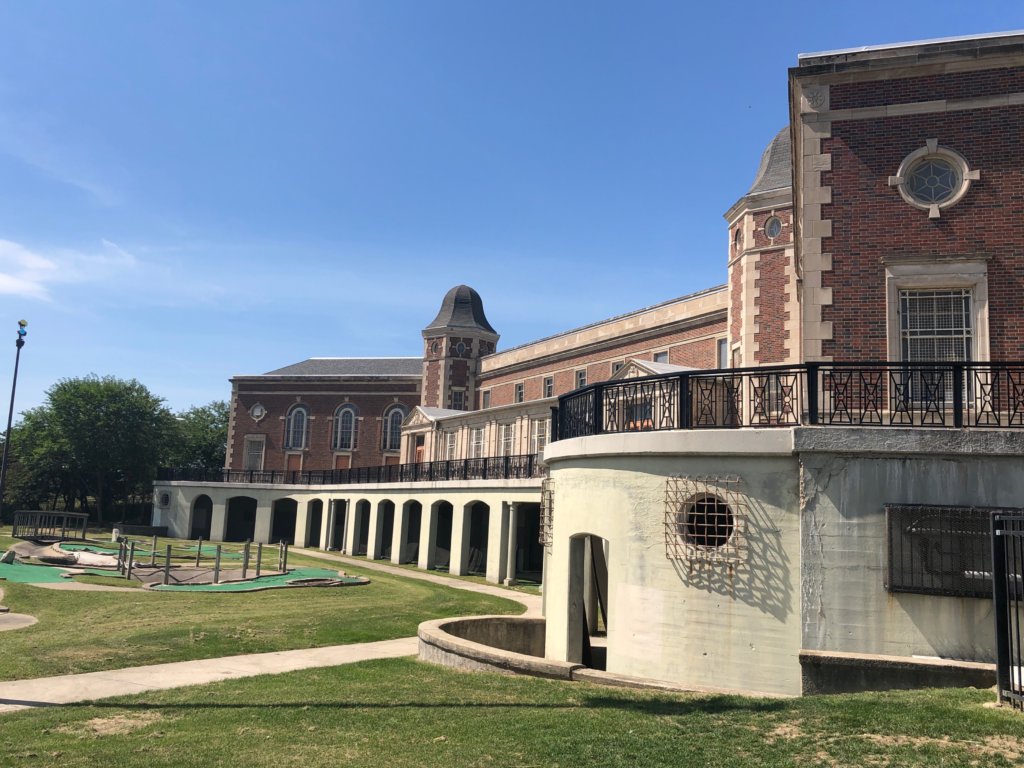
A short walk from the Pink Line station at California is Douglas Park, named in honor of Stephen A. Douglas, a U.S. Senator from Illinois who lost the 1860 presidential race to Abraham Lincoln, also from Illinois. Spanning 173 acres and straddling a few neighborhoods on the city’s West Side (Pilsen and North Lawndale), Douglas Park was built for recreation. It currently houses a miniature golf course, five playgrounds, an outdoor swimming pool, soccer fields, basketball courts and an oval running track. It also features a beautiful lagoon, a wide variety of trees, and an old stone bridge. You can see more of what the Pink Line offers on our Pilsen Chicago Neighborhood tour!
5. Grant Park (Via Any Line Except Yellow)

Also proudly referred to as “Chicago’s Front Yard,” Grant Park is one of the city’s largest green spaces, stretching from Randolph St. on the north to the Museum Campus on the south, Michigan Ave. on the west and Lake Michigan on the east. In addition to baseball diamonds, soccer fields, tennis courts and breathtaking gardens, Grant Park also hosts innumerable food and music festivals and other special events throughout the year. Also part of the greater Grant Park area are Millennium Park, Maggie Daley Park, Buckingham Fountain, The Art Institute, The Field Museum, Shedd Aquarium, Adler Planetarium and two leisure boat harbors. The 313-acre park, one of the largest in the city, can be accessed by any L (except the Yellow Line) at stations throughout the Loop.
6. Gillson Park (Via Purple Line)
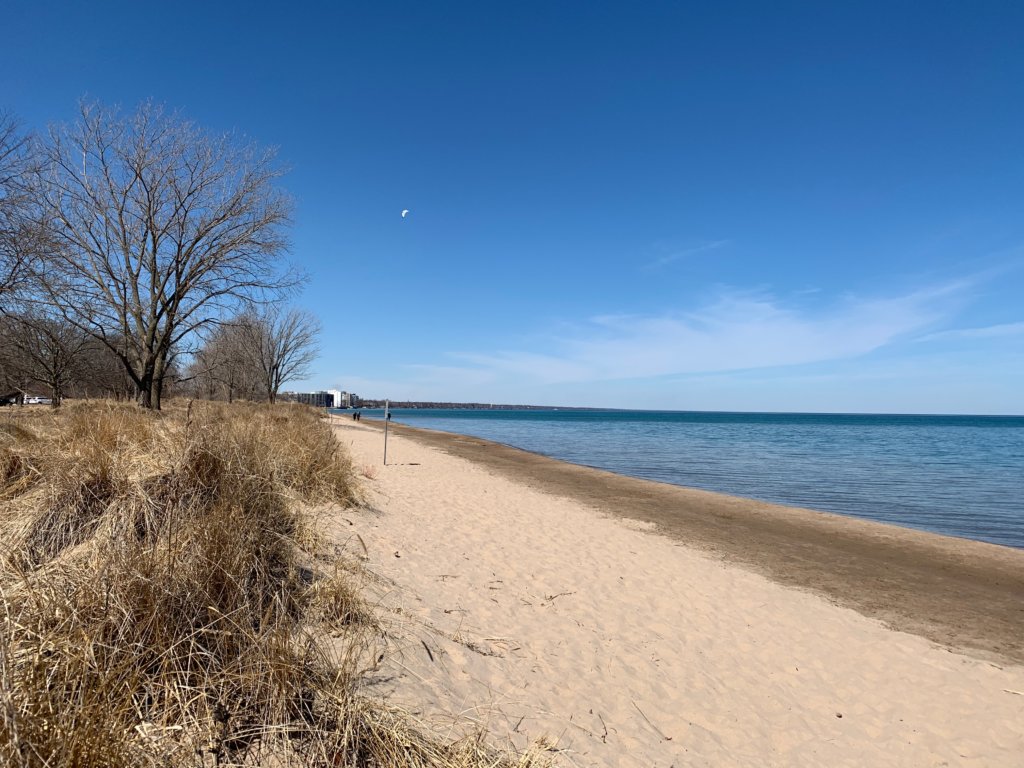
Located in the nearby suburb of Wilmette, Gillson Park is a half-mile walk from the Linden Avenue stop on the CTA’s Purple Line. This beautiful 60-acre park is located on the shore of Lake Michigan and features a public beach, picnic facilities, sailboat and kayak rentals, bicycling, soccer tennis and a wide variety of other recreational activities. Named for the first president of the Wilmette Park District’s Board of Commissioners, Louis K. Gillson, the park opened to the public in 1910.
7. Humboldt Park (Via Blue Line)

Humboldt Park is a 207-acre park on the West Side of Chicago that is located in a community of the same name. The park was named for Alexander von Humboldt, a well-known geographer and naturalist in the mid-1800s. The park features three major historical public buildings, including the Boat House (now a café overlooking the lagoon); the Field House, which includes a fitness center, two gymnasiums, meeting rooms and an inland beach; and the historic Humboldt Park Stables, which is in the process of being converted to the National Museum of Puerto Rican Arts and Culture. Humboldt Park is a 20-minute walk from the Blue Line Damen Ave. stop.
8. Oz Park (Via Brown Line)
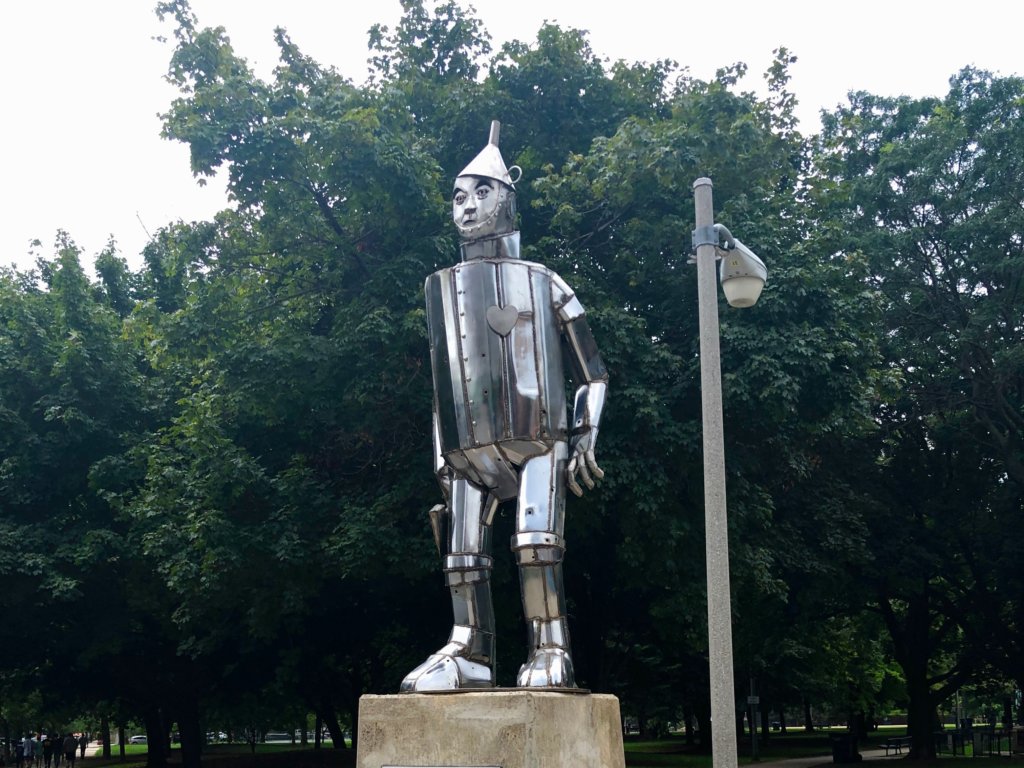
Located in the Lincoln Park neighborhood, Oz Park takes its name from a novel written by Lyman Frank Baum, a former resident of the neighborhood who wrote “The Wonderful Wizard of Oz.” The 13-acre park features sculptures of characters from the novel, The Tin Man, the Cowardly Lion, the Scarecrow and Dorothy and Toto. “The Emerald Garden,” located at the northeast corner of the park, has a path of flowers that visitors can walk through; nearby is “Dorothy’s Play Lot,” which includes swings and climbing equipment for children. Oz Park is located a few blocks from the Brown Line Armitage stop. You can see more of what the Brown Line has to offer on our Historic Pub Tour.
Holder of two journalism degrees, including a masters from Northwestern University, Tom Schaffner is a native of the Chicago area and has spent nearly 50 years as a writer, editor, publisher and professional communications consultant. He was also the founder, editor, and publisher of the Chicago File, a newsletter for former Chicagoans. Tom is also the co-owner of L Stop Tours.
– By Tom Schaffner
While it’s important to keep up with the latest trendy restaurants in town, it’s also important to keep tabs on those eating places known as “joints” — places that have been around forever, have one or several signature items on their menu, have been popular for years, are small, independent or family-owned (not a franchise or corporate chain) and, as often is the case, are unabashedly dowdy in their design, décor and appearance. What you’re about to discover is simply the best food in Chicago.
In my family, we keep tabs on various joints around the city by making it a point to visit one — either a long-time favorite or a new one we’ve just discovered — about once a month. We generally go on Saturdays, usually for lunch, because the time slot allows plenty of time to sleep on a Saturday morning and also because, well, there’s no rush to get back to the office or workplace. On Saturdays, there’s plenty of time to fully wallow in the “joint” experience and savor the food you have purchased.
So with no further ado, here is a list of our very favorite Chicago food joints that we have compiled over the years for your dining pleasure:
Best Food Joints in Chicago
Stony Sub (8440 S. Stony Island Ave.)
You can’t miss the bright yellow building on the west side of Stony Island just past 84th. Inside the structure, every square inch of wall space is covered with signs offering everything from burgers to gyros, wings to subs. Stony Sub is a cash-only joint that offers only food to go. We visited Stony Sub in the summer and took our food across the street and enjoyed a picnic of sorts on the grassy, park-like median that separates Stony Island’s north- and southbound lanes.
Signature Dish: The uniquely Chicago Gym Shoe Sandwich (also known in various parts as the Jim Shoe), which consists of gyro meat, roast beef and corned beef stacked high on an Italian roll with lettuce, tomato, tzatziki sauce (Greek yogurt), Swiss cheese, onions, sweet peppers and giardiniera (hot pickled Italian relish). It doesn’t get any more Chicago than this!
Ricobene’s (252 W. 26th)
Open since 1946, this South Side Italian eatery is located in Bridgeport but is difficult to find. It’s boxed in by two overhead expressways (I-55 on the north and I-90/94 on the south) and also by an above ground rail switching yard immediately west of the restaurant. During the lunch hour you’ll find all types of customers dining there — truck drivers, executives, factory workers and, yes, railroad employees.
Signature Dish: Ricobene’s is known far and wide for its breaded steak sandwich, a massive pile of beef smothered in cheese, peppers, giardiniera and marinara, all of which are packed tightly inside a split French roll. In 2015, USA Today named Ricobene’s breaded steak sandwich the “Best Sandwich in the World;” Anthony Bourdain liked it so much he featured it on his “Parts Unknown” travel show. Years ago, a friend of mine ordered one and just stared at the massive Frisbee-sized concoction when it was placed in front of him. He then looked up, shook his head and said, “This thing’s as big as a disk brake.” It was. But over the next hour or so, he ate every morsel.
Half Shell (676 W. Diversey Pkwy.)
It’s like a little, divey neighborhood bar with kitchy nautical decorations that’s located in the basement of someone’s house, but with one notable exception — this little subterranean gem serves great seafood at great prices.
Signature Dish: Alaskan King Crab legs with herbed garlic butter are extremely popular at the Half Shell, they’re cooked well and you get a lot of them. One reviewer suggests you bring your own kitchen shears so you can attack the pile of shellfish faster. Great advice.
Taurus Flavors (8534 S. Stony Island Ave.)
 The name refers to the original business, an ice cream shop, which was opened at this location in 1966. Some of the unique ice cream flavors are still on the menu, such as black walnut, butter pecan and praline. This is a “joint” in the truest sense of the word, great food (mainly sandwiches) is offered to go (cash only) and the service is fast and the building itself resembles a trailer or mobile home with the windows propped up.
The name refers to the original business, an ice cream shop, which was opened at this location in 1966. Some of the unique ice cream flavors are still on the menu, such as black walnut, butter pecan and praline. This is a “joint” in the truest sense of the word, great food (mainly sandwiches) is offered to go (cash only) and the service is fast and the building itself resembles a trailer or mobile home with the windows propped up.
Signature Dish: The Steak Sweet sandwich, a combination of chopped rib-eye steak, seasonings, grilled onions, cheese, sweet peppers and tomatoes that comes on a steamed bun and is topped with a sweet-savory sauce.
Calumet Fisheries (3259 E. 95th)
You would never suspect that this little, weathered wooden building with the hand-painted signs just a few feet from the Calumet River actually is a James Beard Foundation Award-winning restaurant. It opened in 1948 and is owned and operated today by the same founding family. Without question, it’s some of the best food in Chicago.
Signature Dish: Calumet Fisheries is essentially a smokehouse, you cannot go wrong with anything on the menu that is smoked, particularly the smoked sturgeon, trout and shrimp.

Lindy’s Chili (3685 S. Archer Ave.)
Like most “joints,” there’s nothing fancy here, just a small bar, several tables and walls that are covered with signs and old photos. Lindy’s claims to be “Chicago’s Oldest Chili Parlor” and it probably is — it was founded on this spot in 1924.
Signature Dish: You can order the chili with beans, with mac, without beans, without mac or ladled on top of just about anything, like hot dogs, nachos or burgers.
Cemitas Puebla (817 W. Fulton St.)
Located in Humboldt Park since 2002, this Mexican eatery recently relocated to Fulton Market where it now sports a new, trendier look. Cemitas refers to a sandwich resembling a torta that originates from the Puebla region of Mexico.
Signature Dish: Cemitas Atomica, a breaded pork chop, a chile guajillo marinated pork chop, and ham, along with Oaxacan cheese and avocado served on sesame seed bread.
Johnny O’s (3465 S. Morgan)
Another classic Bridgeport “joint,” Johnny O’s, is a 55-year-old establishment that is kind of a business mash-up — it’s part hot dog stand, part diner, part convenience store and part restaurant. Its split personality aside, they serve fast food that tastes great and is widely considered to be some of the best food in Chicago.
Signature Dish: The Mother-in-Law, a tamale in a hot dog bun, covered with chili and then topped with relish, onions, peppers and tomato slices.
Friistyle (5059 S. Prairie)
Open only for about a year, this South Side eatery has already achieved “joint” status. It serves only dishes that are versions of Belgian-style pommes frites, or, French-fries that are covered with decadent sauces and your choice of protein, such as roast lamb, jerk salmon or chicken wings.
Signature Dish: Italian Beef Frite, Chicago-style Italian beef, Asiago, giardiniera cheese sauce and au jus on a bed of fresh pomme frites.
Johnnie’s Beef (7500 W. North Avenue, Elmwood Park)
A no-nonsense, one-story building with a big glass window that reveals a long line of customers who are waiting for their piping hot Italian beef sandwiches. It has looked this way since the joint opened in 1961.
Signature Dish: Italian Beef, thin slices of seasoned roast beef, simmered and served au jus on a long Italian style roll, usually with giardiniera and sport peppers.
Looking to try some of the best food in Chicago for yourself? Great! Check out our list of Chicago tours now and you could be elbows deep in giardiniera before you know it!
Holder of two journalism degrees, including a masters from Northwestern University, Tom Schaffner is a native of the Chicago area and has spent nearly 50 years as a writer, editor, publisher and professional communications consultant. He was also the founder, editor, and publisher of the Chicago File, a newsletter for former Chicagoans. Tom is also the co-owner of L Stop Tours.
Take a Chicago tour through Instagram and you’ll find diverse and dynamic neighborhoods with many incredible places that would be ideal for the perfect Insta shot. If you’re looking for some of the most Instagrammable places in Chicago, consider these Instagram favorites below and discover some other hidden gems to fill up the social feed that you won’t find anywhere else.
Instagrammable Places in Chicago
- The River Walk
- The Lions at the Art Institute of Chicago
- The Flamingo Rum Club
- Calder’s Flamingo
- Cloudgate (The Bean) at Millenium Park
- Cindy’s Rooftop
- Skyline from North Ave. Beach
- 3 Arts Cafe at Restoration Hardware
- The Stairs in the Rookery Building
- Garfield Park Conservatory
View this post on Instagram
1. Anywhere on the River Walk
By far one of the most popular Instagrammable places in Chicago is the newly refurbished Chicago River Walk. Whether you’re on one of the many bridges or right along the waterfront, there are perfect views from every angle.
View this post on Instagram
2. The Lions at the Art Institute of Chicago
Located at 111 S. Michigan, the Art Institute is the epicenter of culture in Chicago. It’s also home to two famous Chicagoans: the lions which front the museum. They are well known the world over, and instantly recognizable to your Instagram followers.
View this post on Instagram
3. The Flamingo Rum Club
After powering through a mojito or a few mai tais, step outside this popular Wells St. establishment to pose for a few Insta shots in front of the famous flamingo mural. You may have to wait in line (for the mural) but it’s worth it.
View this post on Instagram
4. Calder’s Flamingo
What is it with this city and flamingos? One of the most iconic sculptures in Chicago, the twisted, 53-foot tall, rust-colored flamingo is definitely one of the most impressive sites in the city. And it’s conveniently located off the Brown Line at State and Van Buren at the Harold Washington Library (not a bad place for a few photos either). It could be argued that Calder’s Flamingo is easily one of the best downtown attractions and most Instagrammable places in Chicago.
View this post on Instagram
5. Cloudgate (The Bean) at Millenium Park
No Instagram trip to Chicago would be complete without spending some time in Millenium Park at the Bean (also known as CloudGate). Perfect from every angle, and super fun underneath, go early and stay late and then jump on the Red or Brown Line in moments to tour Chicago like the locals!
View this post on Instagram
6. Cindy’s Rooftop
One of the most stunning vistas in all of Chicago, Cindy’s Rooftop in the Chicago Athletic Club provides a perfect view of downtown, Millenium Park and the lakeshore that will fit perfectly in your Instagram feed.
View this post on Instagram
7. Skyline from North Ave. Beach
Venturing just a few train stops away from downtown on the Brown Line or Red Line (at the Eastern end of North Avenue, is one of the most impressive gateways to the lakefront. Just look south at any time of day (preferably at night) and you’ll be greeted by one of the most stunning views of all Chicago.
View this post on Instagram
8. 3 Arts Cafe at Restoration Hardware
You can only really be outside for three or four months of the year. So where do the hippest and most influential Instagrammers of Chicago go when they need the perfect shot? That’s right – 3 Arts Cafe. A glorious patio outside and high ceilings on the interior with lots of natural light, it’s the perfect location for a memorable Instagram shot.
View this post on Instagram
9. The Stairs in the Rookery Building
Chicago is known for its skyscrapers but there’s a lot more to architecture than just the outside of a building. The landmark Rookery Building on LaSalle Street features a mesmerizing oriel staircase and an amazing light court which is sure to make your Instagram followers applaud your trip to Chicago.
View this post on Instagram
10. Garfield Park Conservatory
A long winter in Chicago doesn’t mean that nature isn’t around – this is the “City in A Garden” after all, but sometimes that garden is indoors! Just a short ride from downtown (this destination is also part of L Stop’s Chicago Pedway tour), the warm and semi-exotic air of one of the nation’s top indoor gardens presents two whole acres of photo-worthy nature moments in some much needed warm air.
There are, of course, far more Instagrammable places in Chicago that we didn’t mention! If you’re looking for a Chicago city tour guide that knows all the right Instagram spots, check the schedule for upcoming Chicago walking tours and find some real hidden gems.
– By Tom Schaffner
When I was in my early twenties, I worked in an office on North Michigan Avenue near the Wrigley Building. My home at the time was in East Lakeview — 3.7 miles north of the office.
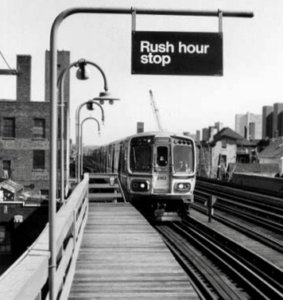 Every day after work I had a difficult transportation decision to make in order to get home — take the L (usually too crowded), take the bus (generally too slow) or take a cab (always too expensive). There were no ride-sharing businesses in those days and even if there had been, we didn’t have smartphones with which to initiate an order. Many evenings I chose to walk home, a journey that would take about one hour and 15 minutes if no stops were made along the way.
Every day after work I had a difficult transportation decision to make in order to get home — take the L (usually too crowded), take the bus (generally too slow) or take a cab (always too expensive). There were no ride-sharing businesses in those days and even if there had been, we didn’t have smartphones with which to initiate an order. Many evenings I chose to walk home, a journey that would take about one hour and 15 minutes if no stops were made along the way.
When I wasn’t in a hurry, I’d take my sweet time and make all kinds of stops on the way home. The best walks were those where I explored the many bars, taverns, and saloons that populated my meandering path home. After much trial and error, I developed a sacred list of favorite establishments — a list that I would later describe as “The Ultimate Pub Crawl.” It was a wide array of drinking establishments — old standards, singles bars, places with happy hour and appetizer specials, bars with 4 a.m. licenses, and many more. Literally, a cornucopia of drinking joints.
Although many of my favorites vanished long ago, the vast majority of “Ultimate Pub Crawl” joints are, incredibly, still in business 40 years later — a testament to their stamina and staying power. Here, in proper order, is the “Ultimate Pub Crawl” — drinking establishments that were popular in 1980 and are still going strong:
Chicago Pub Crawl
- Billy Goat Tavern
- Pippin’s Tavern
- Hangge-Uppe
- Butch McGuire’s
- The Lodge
- Old Town Ale House
- Marge’s Still
- Kincade’s Bar & Grill
- Glascott’s Groggery
- Burwood Tap
- Durkin’s
Billy Goat Tavern (430 N. Michigan Ave.)
A dingy, subterranean watering hole that screams “old school” from the second you descend the steps from the front door. The place hasn’t changed a bit in 40 years — a thin film of brown grease (from years of frying “dobla-cheez” burgers) taints the pictures and other framed objects on the walls and laminate tabletops feature red and white checkered squares that are printed on them. From the “Billy Goat Curse” to the famous sketch depicted on Saturday Night Live, Billy Goat Tavern is a bar that should be on every Chicago pub crawl.
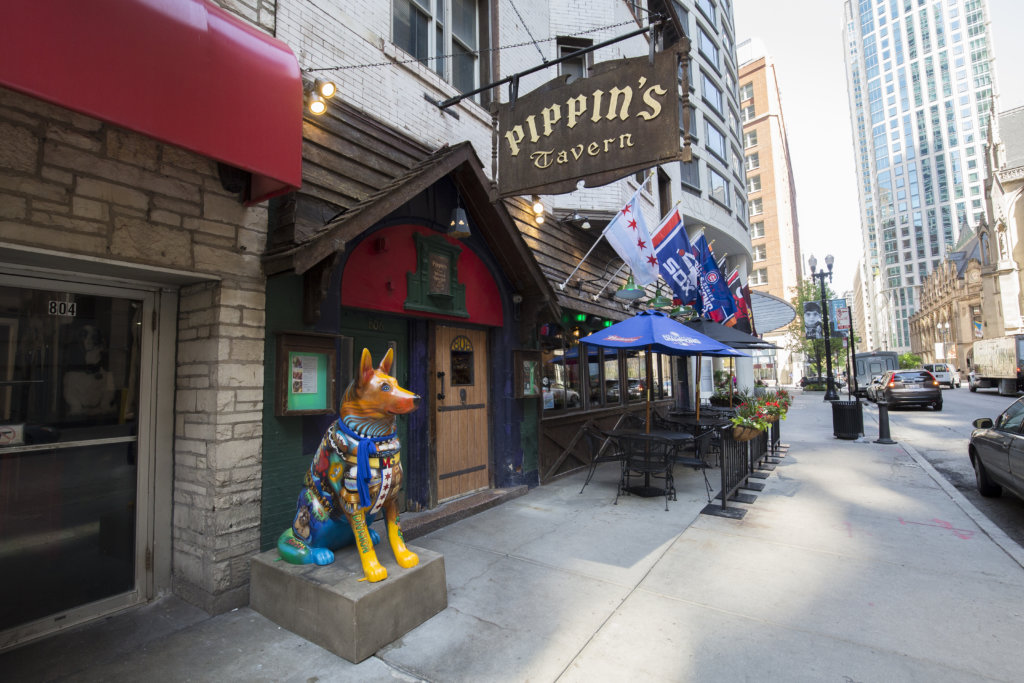
Pippin’s Tavern (39 E. Chicago Ave – Recently moved)
A ten-minute walk from Billy Goat, Pippin’s is a great little tavern that has been serving thirsty Chicagoan’s since the 1970s. Unlike other establishments in the area, Pippin’s is small and unpretentious with a cozy, comfortable feeling to it. Back in the day, Pippin’s was frequented by airline crew members who were overnighting at nearby Michigan Avenue hotels; today it attracts a wide array of guests, serves upscale food, and is open only until midnight (however, its nearby sister tavern, Streeter’s, retains a 4 a.m. liquor license).
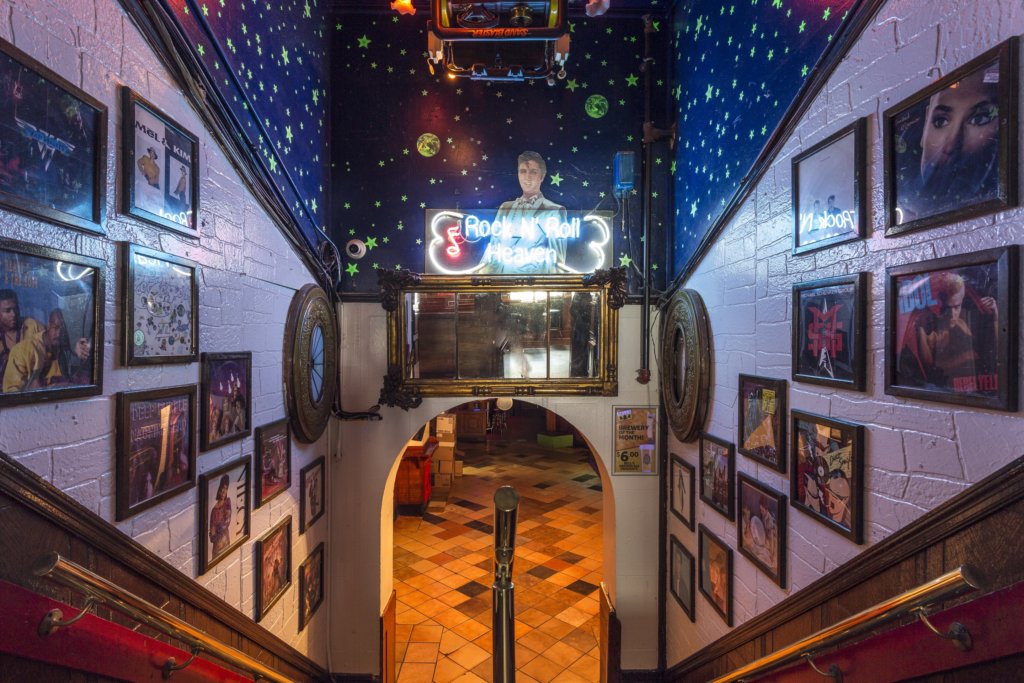
Hangge-Uppe (14 W. Elm)
I would have voted this bar the “Least Likely to Survive as a Business” in 1980 but here we are, more than 40 years later, and the Hangge-Uppe is still going strong. Upstairs is still “disco-like” with a lit dance floor and DJ; downstairs is the self-proclaimed “Rock and Roll Heaven” which features a number of bars, loud, piped-in rock and roll music and wall-to-wall-people. The Hangge-Uppe is a great place to have a drink, people watch, and then move on to the next bar.
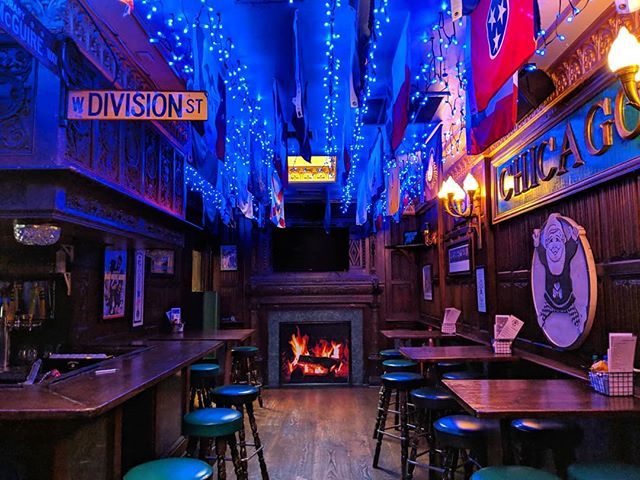
Butch McGuire’s (20 W. Division)
Butch McGuire opened this tavern on Division St. in 1961 and in so doing, created the world’s first “Singles Bar,” a place where it would be easy for people to meet one another, enjoy quality food and cocktails and have a good time. Over the years the bar claims to have served more than 23 million glasses of beer and is single-handedly responsible for thousands of people not only hooking up but, ultimately, getting married. Though the nightclub intensity of Division and Rush Street has dropped considerably in recent years, Butch McGuire’s is still a good place to get a drink on your long walk to Lakeview.
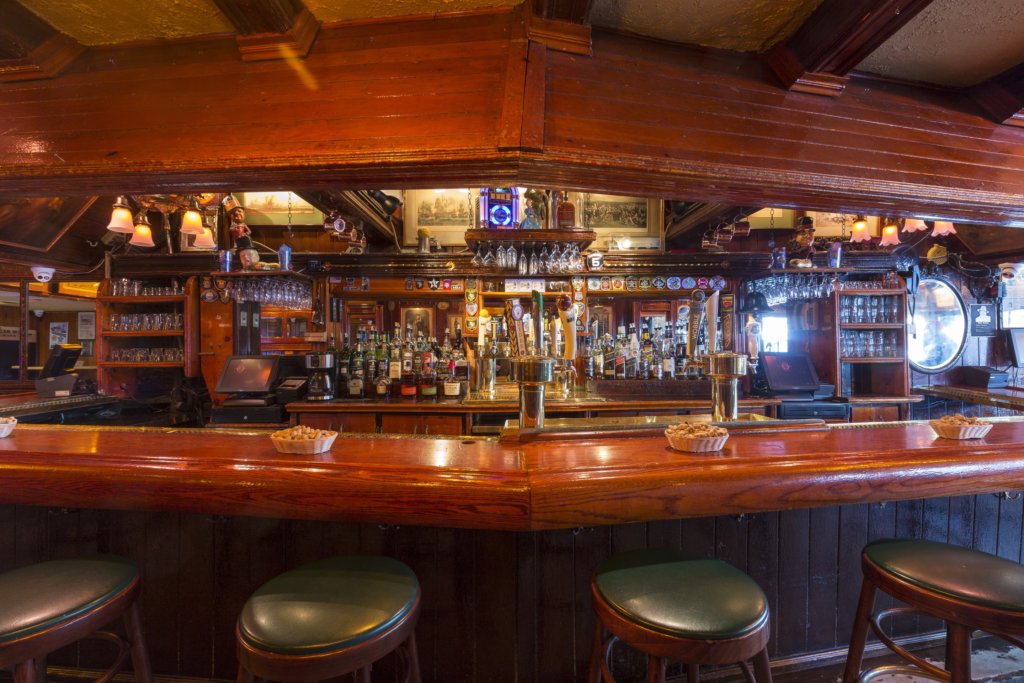
The Lodge (21 W. Division)
Located across the street from Butch McGuire’s, the Lodge Tavern pre-dates Butch’s by four years, making it the senior member of the Rush Street entertainment district. By Rush Street standards, the Lodge is on the small side and feels quite crowded on a Friday or Saturday night when things get cranked up. For the Ultimate Chicago Pub Crawl, it’s worth a shot and beer…and then on your way.
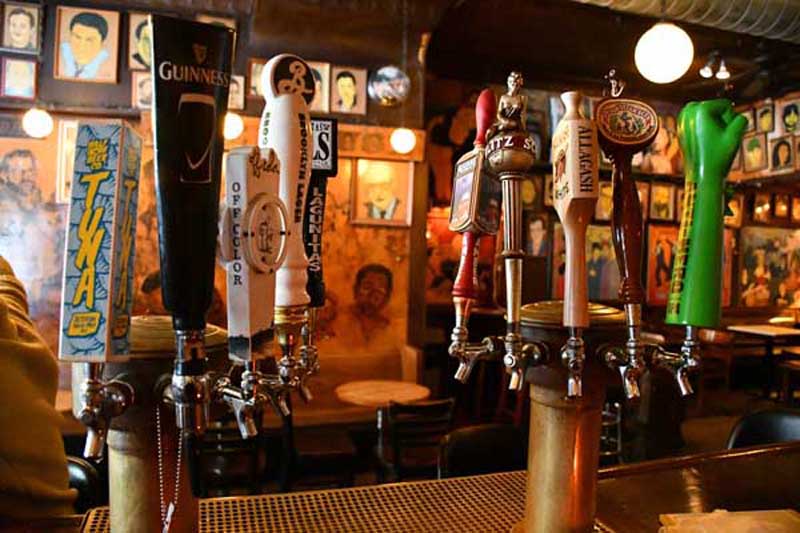
Old Town Ale House (219 W. North Ave)
Perhaps the “diviest” bar on the Ultimate Chicago Pub Crawl, the Old Town Ale House knows what it is…and is proud of it. Cheap beers, sawdust on the floor, old books scattered throughout and veteran tipplers seated at the bar who’ve been coming here for years. The original bar caught fire and then moved across the street to the current location in 1971. It was supposed to be a temporary move but the bar is still there today. You won’t find a drinking joint in Chicago with more “character” than this one.
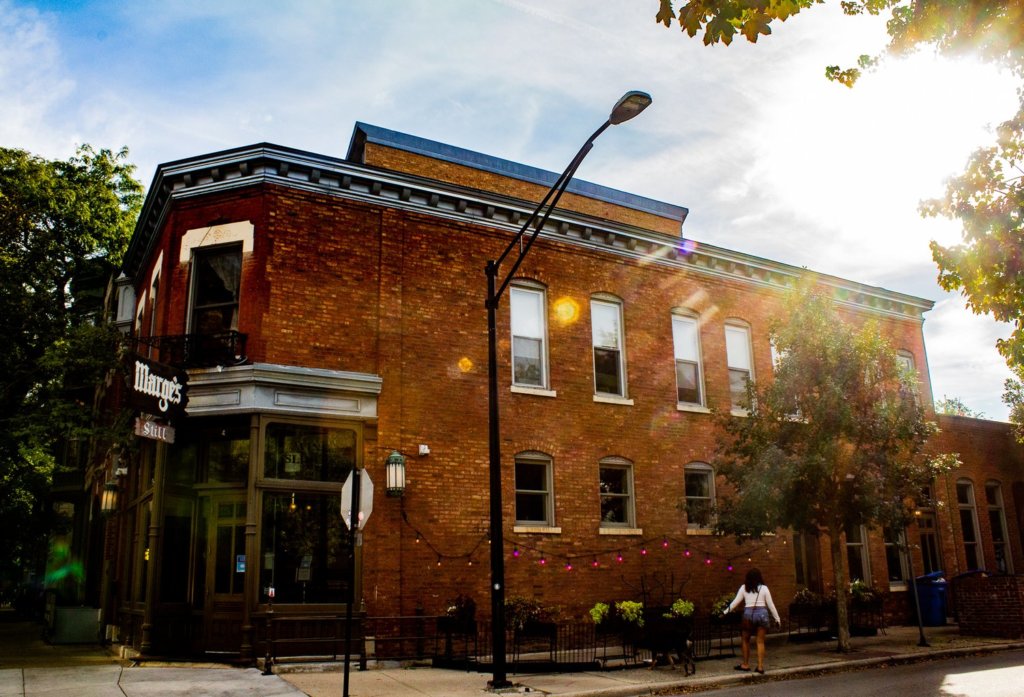
Marge’s Still (1758 N. Sedgwick)
Every Chicago pub crawl has to have the quintessential corner tavern on its agenda and for the Ultimate Pub Crawl, Marge’s Still fits the bill. The building it is housed in dates to 1885 and the tavern was operated as a speakeasy during Prohibition (gin was made in the bathtub on the second floor). Previous owner Marge Lednick passed on in 2001 but the bar survives with her name.
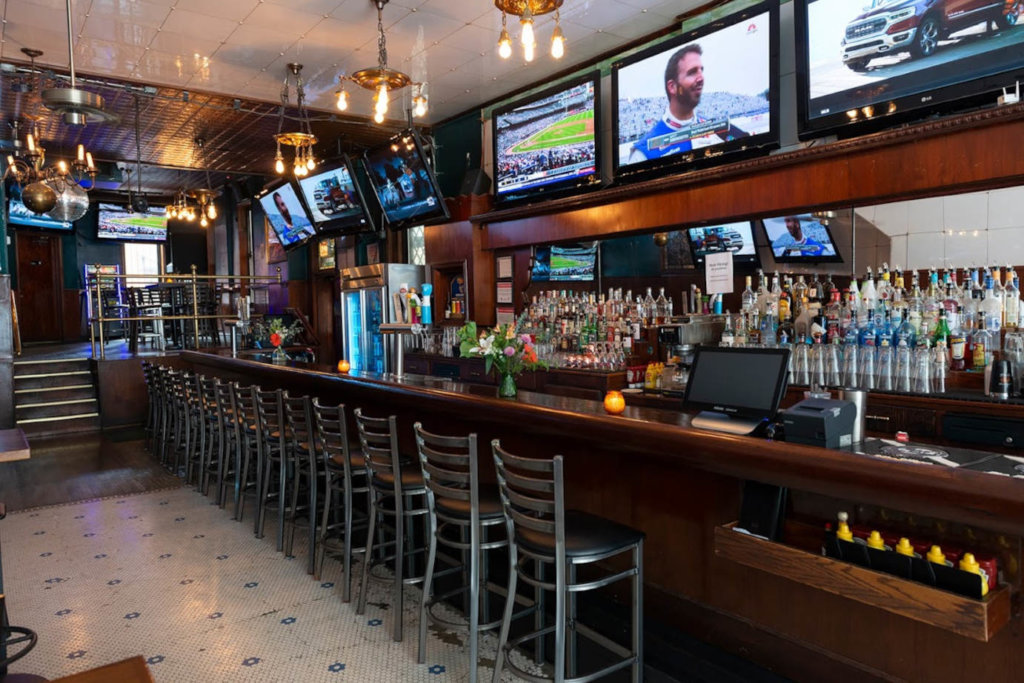
Kincade’s Bar & Grill (950 W. Armitage)
Established in 1986, Kincade’s is one of the “younger” bars on this circuit. It is primarily a sports bar and has special allegiances with certain college teams, such as Northwestern University and the University of Kansas, which is odd because DePaul University is literally right across the street. The bar is convenient to the Brown Line (elevated train) in case you are looking to abandon the pub crawl early.
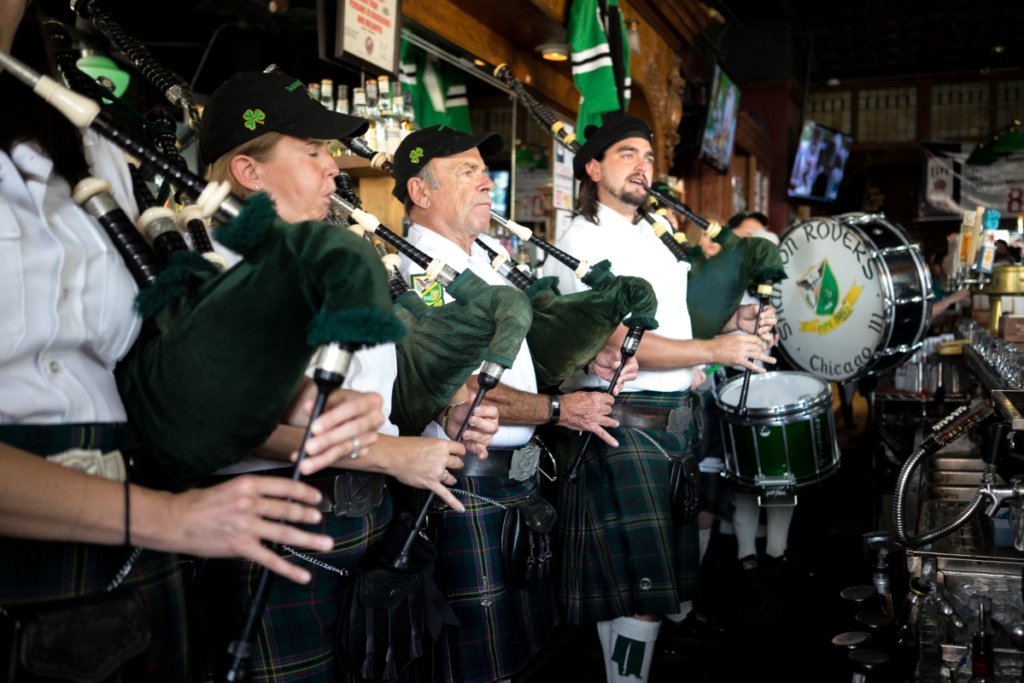
Glascott’s Groggery (2158 N. Halsted)
You are now officially in Lincoln Park and if you are still hoofing it from bar to bar, you have walked 2.9 miles from Billy Goat Tavern. Congratulations, you deserve a drink. Glasscott’s, run by various members of the Glascott family since 1937, offers 15 beers on tap, more in bottles, wine by the glass and a wide variety of liquor. The décor inside is classic Chicago neighborhood bar — mahogany bar, tin ceiling, white hexagonal floor tile, high backed wooden barstools and a game room in the back.
Burwood Tap (724 W. Wrightwood)
Another tavern owned and operated by the same family since 1933. Inside the bar is a large photograph of Burwood regulars — one of them is named Leroy Brown and he served in the Navy with a songwriter by the of Jim Croce, who would later write a song about him called, “Bad, Bad Leroy Brown.” Located in the middle of a quiet residential neighborhood, Burwood Tap is a classic neighborhood bar.

Durkin’s (810 W. Diversey Pkwy)
The last stop on the Chicago pub crawl is Durkin’s which, since 1933, has held the longest continuous beer license on the city’s North Side. It calls itself an Irish bar, but it’s really just another neighborhood sports bar — lots of large-screen televisions with sports on all the time. This is a shot and a beer joint — drink up, pub crawlers.
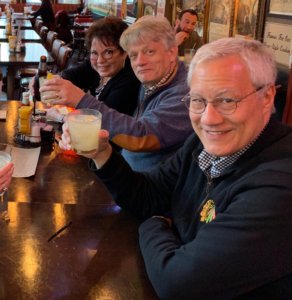
There you have it — 11 bars, 3.7 miles, all on foot. The Chicago pub crawl requires pacing and a bit of stamina, no doubt about it. But it is a beautiful walk, on the way you see North Michigan Avenue, the Rush Street entertainment district, Old Town, DePaul, Lincoln Park and Lakeview.
Happy pubbing (or crawling, as the case may be).
Cheers!
Holder of two journalism degrees, including a masters from Northwestern University, Tom Schaffner is a native of the Chicago area and has spent nearly 50 years as a writer, editor, publisher and professional communications consultant. He was also the founder, editor, and publisher of the Chicago File, a newsletter for former Chicagoans. Tom is also the co-owner of L Stop Tours.
– By Tom Schaffner
Everyone is familiar with Chicago’s prominent museums — Field Museum of Natural History, Museum of Science and Industry, Art Institute, Chicago History Museum, Museum of Contemporary Art, Adler Planetarium — but the majority of visitors to Chicago aren’t aware of the many smaller, special interest museums located throughout the City that offer great educational, cultural and entertainment value to anyone willing to invest a little time and effort into finding them.
Museum of Broadcast Communications
Because it has changed locations several times in the past 25 years, the Museum of Broadcast Communications has been a difficult museum to locate much less visit since coming into existence in the late 1980s (for eight and a half of those years, it didn’t even have a home). Now located in a self-built structure at 360 N. State Street, the Museum’s itinerant days appear to be behind it for good. And for visitors, that’s a really good thing.
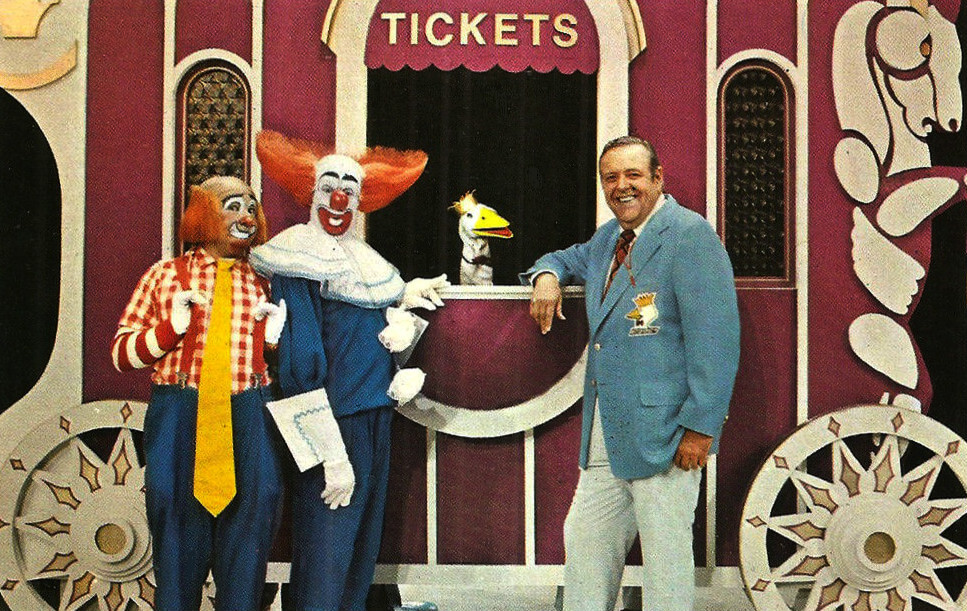
Thanks to geography, Chicago in the 1920s was one of the nation’s early broadcasting centers. Its central Midwest location not only allowed its early radio stations to be widely heard — from the eastern seaboard to the Rocky Mountains — the geography also allowed Chicago to become a logical switching point for transcontinental network lines, enabling local production facilities to easily and efficiently re-feed programming to various time zones nationwide. The City’s early role as a broadcasting center is one of the primary reasons the Museum is located in Chicago.
The mission of the Museum of Broadcast Communication is to collect, preserve and present historic and contemporary radio and television content and artifacts and make it available to the public for educational, informational and entertainment purposes. The Museum has an extensive archive of clips and episodes from radio and television programs over the years and serves as the headquarters of the National Radio Hall of Fame. Additionally, it has curated and collected artifacts from locally produced programs like the “Oprah Winfrey Show,” “Garfield Goose and Friends,” and the “Bozo Show” and a current exhibit at the Museum, “Saturday Night Live: The Experience,” was recently extended through March 31, 2019.
American Writers Museum

The reason this museum is not well known is because it is new — the American Writers Museum opened its doors in May 2017 — and because it is hidden on the second floor of a downtown office building (180 N. Michigan Ave.).
In its short life span, however, the museum has already racked up some pretty impressive awards. Shortly after it opened, the Museum was listed first by Fodor’s Travel as one of “World’s 10 Best New Museums.” Six weeks later, the Writers Museum was named “Best Illinois Attraction” in a survey by USA Today/Reader’s Choice.
The first museum of its kind in the United States, the American Writers Museum celebrates American writers and explores their influence on our history, our identity and our daily lives. The Museum features a wide array of interactive exhibits that focus on various aspects of writing, great authors and their works, Chicago writers and their contributions to literature, and much more. The Museum also hosts a number of special events and programs — “Bob Dylan Electric” is an exhibit running through April 30, 2019 that explores the cultural influences and writing talents of the winner of the 2016 Nobel Prize for Literature; “Frederick Douglass: Agitator,” which runs through May 31, 2019, explores the powerful words used by Douglass in his fights against slavery and racism.
McCormick Bridgehouse & Chicago River Museum
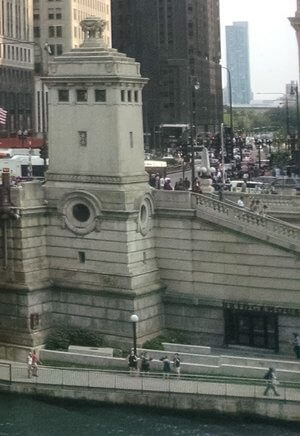
There just aren’t many museums in the U.S. — or in the world, for that matter — that are housed in a bridge-tender’s tower located astride an iconic urban river. Such an unlikely location for a museum, as well as its small size, are why this particular venue is not heavily trafficked, it doesn’t look at all like a museum.
It’s an interesting place to visit, however. When the Michigan Avenue museum is open (May 1 –Oct. 31) and the bridge needs to be raised for boat traffic, visitors can walk down its stairs to the river’s edge and watch the huge mechanical gears turn as counterweights drop and, with teeter-totter-like precision, lift both sides of the trunnion-bascule bridge so that the roadway sections are pointing straight to the sky, perpendicular to the water. This happens about 100 times between April and November, and typically occurs on Wednesdays or Saturdays.
The museum also tells the stories of the Michigan Avenue Bridge and the Chicago River — how both the bridge and museum are now located on the site of historic Fort Dearborn, how the bridge was chiefly responsible for the growth of the City north of the Loop and the role of the River in the development of Chicago and how its direction was “reversed” in the early 1900s in order divert waste and sewage away from Lake Michigan.
Interested in exploring all that this city has to offer? Book one of our Chicago tours today!
Learn more about Chicago in the L Stop Blog
Holder of two journalism degrees, including a masters from Northwestern University, Tom Schaffner is a native of the Chicago area and has spent nearly 50 years as a writer, editor, publisher and professional communications consultant. He was also the founder, editor, and publisher of the Chicago File, a newsletter for former Chicagoans. Tom is also the co-owner of L Stop Tours.
– By Tom Schaffner
Now It’s Called…
Earlier this year, the new owners of the John Hancock Building announced that the 100-story building on North Michigan Avenue will no longer be called the “John Hancock Center.” For the time being, the building will simply be known by its address — 875 N. Michigan Ave.
Nevertheless, people will still call it the Hancock Building, just as they still say “Sears Tower,” even though the building was officially changed to Willis Tower in 2009. Old habits are hard to break.
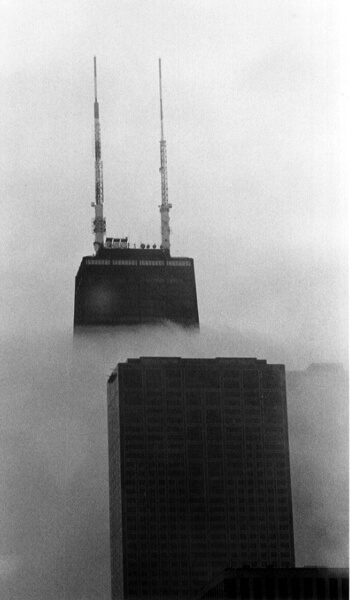
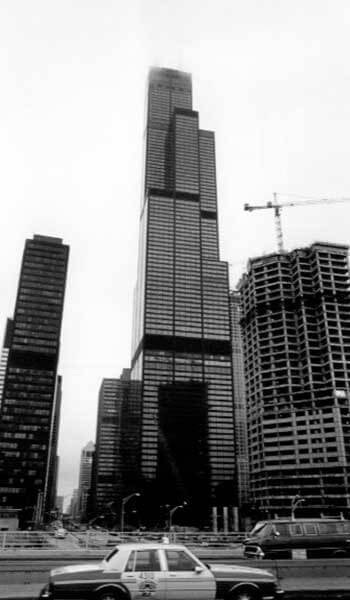
News of the name change for the Hancock Building got us thinking — what other iconic Chicago buildings have undergone name changes to the point that it’s difficult to remember its most current moniker? Here are a few we came up with:
Crain Communications Building (150 N. Michigan Ave)— You’ve seen this building, it’s the one that looks like it was sliced off at the top into a diamond shape. It was built in 1984 by Associates Commercial Group and was named Associates Center, until the firm moved out in 1989. New building tenants renamed it the Smurfit-Stone Building and, later, the Stone Container Building, until 2012. That’s when Crain Communications (publishers of Crain’s Chicago Business, Advertising Age, Auto Week) relocated their Chicago headquarters into the building.
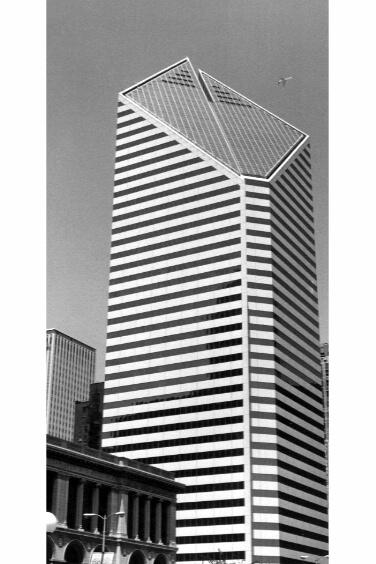
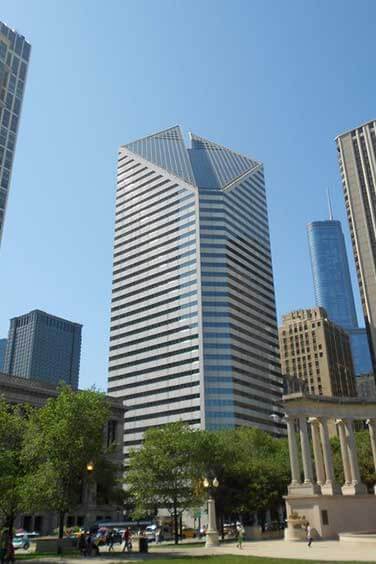
Guaranteed Rate Field (35th and Shields) — We’ve only had to live with this horrible moniker for a baseball stadium for two years (so far), but prior to that it possessed an equally horrible moniker, U. S. Cellular Field (nicknamed “The Cell” by fans). That name lasted from 2003 until 2016. In the era before “naming rights” were sold to the highest bidder, the stadiums located at this intersection (the original was across the street from the current one) were known, alternatively, as Comiskey Park (1912-1962 and 1975-2003) and White Sox Park (1910-1912 and 1962-1975).
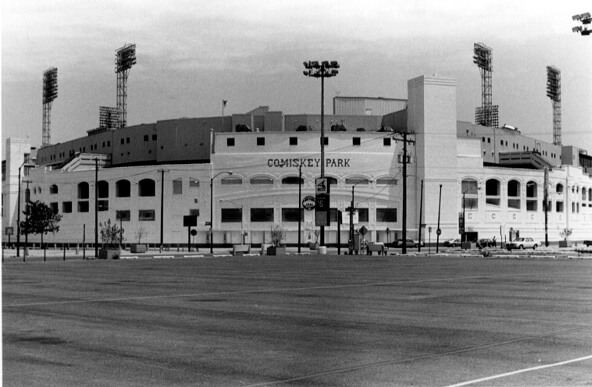
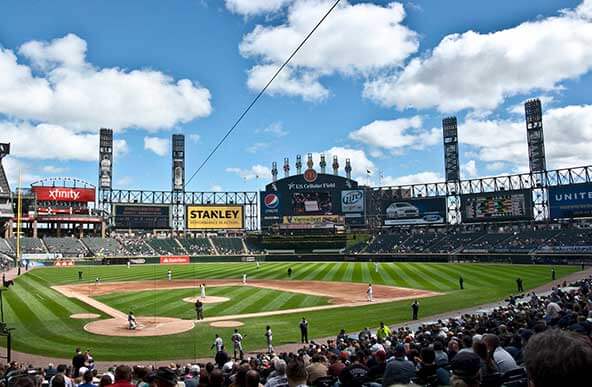
Richard B. Ogilvie Transportation Center (500 W. Madison) — The original structure on this site was built by the Chicago & North Western Railway in 1911 and was called the Chicago & Northwestern Terminal until the station’s head house was demolished in 1997 and replaced by a 42-story office building called Citicorp Center. Later that same year, the building, which rises above the below-street-level tracks, was renamed after Richard B. Ogilvie, a former Board member of the Milwaukee Road Railroad, a governor of Illinois and the creator of the Regional Transportation Authority.

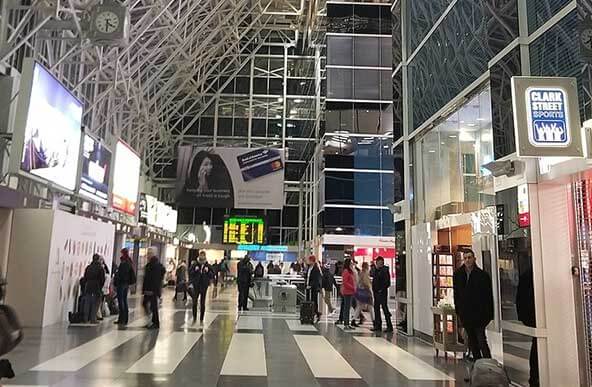
Palmolive Building (919 N. Michigan Ave.) — This beautiful Art Deco building, the one with the beacon on top, was built in 1929 by the Colgate-Palmolive-Peet Company and, for the next 36 years was known as the Palmolive Building. In 1965, Playboy Enterprises moved its editorial and business offices into the building and it became the Playboy Building, as evidenced by the huge PLAYBOY letters across the outside of the top floor. Playboy vacated the building in 1989 and for the next 12 years it was known by its street address, 919 N. Michigan Ave. In 2001, the new owners of the building decided to restore the Palmolive name, which remains in place today.
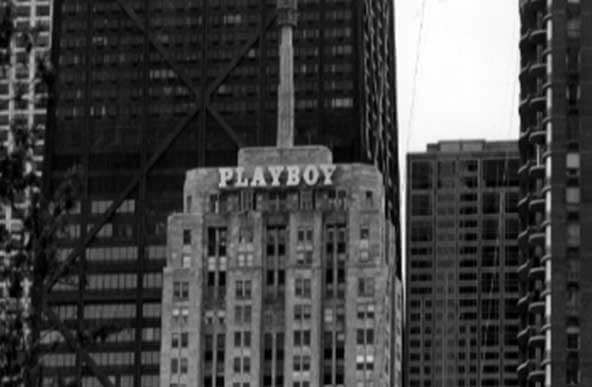

680 N. Lakeshore Drive (680 N. Lake Shore Drive) — From 1926 until 1984, this full-square-block building was known as the American Furniture Mart and it had a different address — 666 N. Lake Shore Drive. After the Mart went through some difficult financial times, Chemical Bank of New York purchased the building and immediately decided to change the building’s address. The bank said it was to distance the building from its troubled financial past; others claimed the number 666 was “cursed” and was a veiled reference to the number of the Beast from the book of Revelation. In the early 1990s, the building was converted into condominiums and has been identified by its new street address ever since.
Book one of our L Stop Tours to see these iconic Chicago buildings up close and personal.
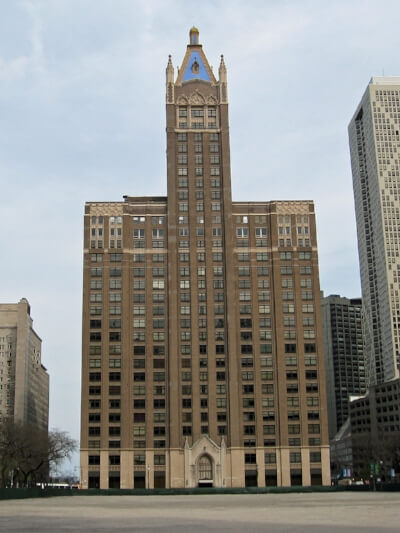
Learn more about Chicago in the L Stop Blog
Holder of two journalism degrees, including a masters from Northwestern University, Tom Schaffner is a native of the Chicago area and has spent nearly 50 years as a writer, editor, publisher and professional communications consultant. He was also the founder, editor, and publisher of the Chicago File, a newsletter for former Chicagoans. Tom is also the co-owner of L Stop Tours.

